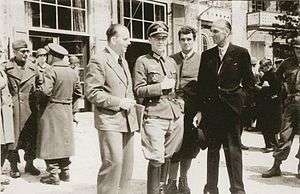Transport of concentration camp inmates to Tyrol

The transport of inmates of German concentration camps to Tyrol occurred in late April 1945 during the final weeks of the Second World War in Europe. Large numbers of high-profile prisoners were moved to Alpine Fortress – in the Operational Zone of the Alpine Foothills – on the orders of the government of Nazi Germany. The transport's SS guards had orders to kill everyone if liberation by the advancing Western Allies became imminent. However, in the south Tyrol region, regular German troops took the inmates into protective custody. The entire group was eventually liberated by advanced units from the Seventh Army.[1]
Transfer and liberation
On 17, 24 and 26 April 1945 141 prisoners from Dachau Concentration Camp were transferred to “Arbeitserziehungslager Reichenau”, Innsbruck, Austria. But the camp was not prepared to keep the prisoners. Instead the prisoners were sent to a hotel near Niederdorf/Hochpustertal 70 km northeast of Bozen, Italy, where they arrived on 28 April.
The transport, which was composed of trucks and old buses, was guarded by several dozen troops from the SS and SD. On board were the camp's most important and prominent prisoners and family members of the 20 July plotters. The officers in charge, Obersturmführer Edgar Stiller and Untersturmführer Bader, had orders to kill all the prisoners if in any fear of capture.
Contrary to expectations, the Pragser Wildsee Hotel was unavailable as it was being used by three German Wehrmacht generals. A delegation from the prisoners' committee—that included Colonel Bogislaw von Bonin who had been imprisoned for allowing a retreat on the Eastern Front—made contact with the Wehrmacht HQ in Bozen and made known the identity of the high-status prisoners and the fear that they were to be executed before liberation by US troops.
A message was sent to Wehrmacht troops at Sexten 17 km east of Niederdorf commanded by Captain Wichard von Alvensleben, who decided to come and protect the prisoners with his soldiers.
On 30 April against the background of advancing US troops and Alvensleben’s unit, which had now surrounded the village, the SS guards decided to escape.
The freed prisoners were then accommodated at the Pragser Wildsee Hotel until advanced units from the 42nd Infantry Division and the 45th Infantry Division reached Niederdorf on 5 May 1945.
List of the prisoners
|
|
Notes
Citations
- ↑ "Defeat And Deliverance 1945 (newsreel containing the liberation)". British Pathé News. Retrieved 9 May 2015.
- 1 2 Peter Koblank: Die Befreiung der Sonder- und Sippenhäftlinge in Südtirol, Online-Edition Mythos Elser 2006 (German)
- ↑ 'Endgame 1945 The Missing Final Chapter of World War II'
- ↑ Austrian Requiem
- ↑ Niels-Birger Danielsen. "Modstand Frihedskampens Rødder 1933–1942" (in Danish). Politikens Forlag. ISBN 9788740015447. Retrieved 14 February 2016.
- ↑ Thorkild Nielsen, Egon Jensen (2013). "Optrevlingen af Aarsgruppen februar 1944" (PDF) (in Danish). Vesthimmerlands Museum. p. 5. Retrieved 14 February 2016.
References
- Hans-Günter Richardi, SS-Geiseln in der Alpenfestung ISBN 978-88-7283-229-5 (German)
- Pragser Wildsee.com (German)
- Peter Koblank: Die Befreiung der Sonder- und Sippenhäftlinge in Südtirol, Online-Edition Mythos Elser 2006 (German)
- ECHO Tirol 10 November 2005 (German)
- Fey von Hassell, Hostage of the Third Reich: The Story of My Imprisonment and Rescue from the SS, ISBN 978-0-684-19080-8
- Endgame 1945 The Missing Final Chapter of World War II ISBN 978-0-316-10980-2
- Klaus-Dietmar Henke, Die amerikanische Besetzung Deutschlands, ISBN 3-486-56175-8 (German)
- Kurt von Schuschnigg: Austrian Requiem, Victor Gollancz 1946, London.